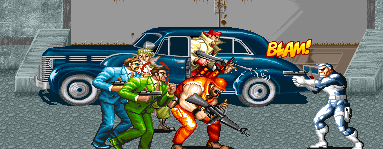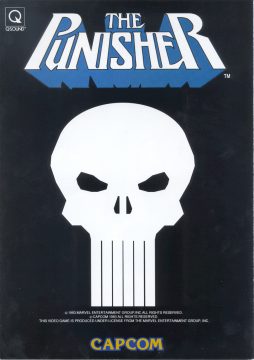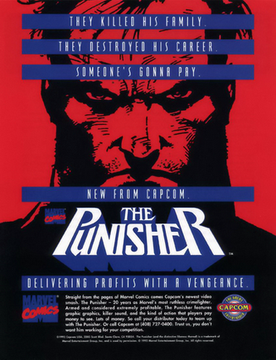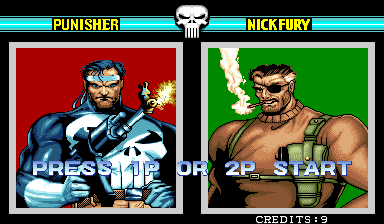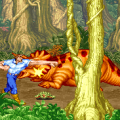The Punisher will probably never be Marvel’s most A-List hero, but he will probably be the easiest to make a video game out of. As a normal person who deals with his opponents by simply shooting them, you think there’d be the potential for dozens of games. Despite this, Frank Castle never got quite as many game adaptions as, say, Wolverine or Spider-Man, but there’s still plenty to choose from. Capcom’s first run with the Marvel universe is probably one of the best, a great brawler that does the license more than proud. Besides, if there’s any character who it’d be most in character for to have him go around and beating hundreds of criminals to death, it’d definitely be The Punisher.
After ex-Marine Frank Castle had his family killed in the crossfire of a mob war, he’s dedicated himself to killing every criminal he can find. He’s now after the Kingpin, New York’s biggest crime boss, and Frank’s violent quest will take him on a cross-country rampage. Joining him as Player 2 is Nick Fury, special agent of SHIELD and no slouch in kicking ass, himself. In a nice touch, both characters have different dialogue whether they’re alone or together, and a co-op playthrough has Fury complaining constantly about the Punisher’s methods. There’s also some brief cutscenes between stages, none of which are particularly necessary, but do enough to provide context to things.
Frank & Nick play identically to one another, so to compensate, there’s a somewhat larger arsenal of moves and techniques than previous Capcom brawlers. Aside from the standard set of moves from a Capcom brawler, you can rebound off of enemies with your jump kicks, slam enemies into the earth with a classic izuna drop, and perform a shockwave kick to knock away attackers. In one of the most satisfying moves of any beat-em-up, you can also extend the range of your crowd-clearing special move by swinging an opponent around by the legs, knocking away approaching foes. You’re also able to pick up and chuck many of the objects found throughout the environment, including chairs, barrels, and even prone enemies, and toss them around to inflict further damage. Finally, you can collect and make use of grenades, which can be used up for several different special moves when you’re too low on life to perform a standard one.
Your character will also pull out a pistol any time armed or robotic enemies appear on screen, holstering it once those threats no longer remain. You’ll automatically target whatever enemy is closest, so once your gun’s drawn, all you have to do is pound the fire button until everything in your general direction is dead. (The Punisher’s not exactly known as the sporting type, so maybe he’s just trying to conserve ammo by not just having his gun drawn at all times?) These segments, while plenty of fun, can at times be frustrating, due to the game’s tendency to not target the closest threat. It’s not a massive issue, since most of your moves are still available to you, but it requires a certain level of extra focus that the rest of the game doesn’t always ask for. The game also drops plenty of weaponry, possibly more so in sheer number than any other brawler. While these include standbys like swords and throwing knives, you’ll also find uzis, flamethrowers, and even the occasional assault rifle.
Even despite the fact that you essentially only have one character, the larger moveset and emphasis on weaponry more than makes up for that fact. It also helps that it builds on some incredibly satisfying combat, every aspect of it adding greatly to the over the top comic book styling. Strong hits send enemies flying into walls and through each other, complete with visible sound effects to sell the impact. The ability to send opponents flying all over the screen with your attacks and throws really help to sell just how much of a badass Frank & Nick are supposed to be, especially when the screen gets especially packed with goes. There’s just a certain feel to it that so few beat-em-ups, even some in Capcom’s own stable, really manage to get nail.
The only one true flaw with the game is that its pacing feels somewhat lopsided, at times. While the first few levels go through pretty quickly, later levels start to drag on just long enough to cause annoyance. Still, the core gameplay is good enough that it never entirely overstays its welcome, overall leading to a game that’s more than worth replaying. The fact that Frank & Nick have their own dialogue when separated or together also helps to add a little replay value, as well. The game’s also more than approachable for those not into comics, although you’ll get a little more out of it if you happen to be a Marvel fan. The slaying of Frank’s family is a pixel art recreation of a page from Punisher War Journal Volume 1, for example, while X-Men villain Bonebreaker shows up as a boss.
The sprites on screen are large and well animated, with plenty of enemy variety to be seen even amongst the most basic of mooks. The bosses are especially impressive, including the multi-segmented Guarddroid who shows visible damage, and the absolutely massive sprite that is the Kingpin himself. In another nice touch expected of a Capcom beat-em-up, the continue screen features the protagonists receiving CPR from their teammates, with their success depending on your quarter situation. The sound effects are satisfying meaty and help add to the visceral thrill of the combat. The angry screaming of the player characters also adds a lot, as while it’s incredibly overacted, it’s so over the top that you can almost feel the visceral rage behind it. It’s a small touch, but one that really helps to get you to indiscriminately murder some criminals.
The game’s only port was released for the Sega Genesis by the generally mediocre Sculptured Software. The smaller sprites, removal of various background details, and cuts in the audio are disappointing, but understandable. Even the censorship, including the removal of all blood, less skimpy outfits on the female ninja enemies, and Nick Fury’s cigar, are acceptable. (Having the Punisher not kill the first boss definitely stretches it, however.) What’s not acceptable is how off this port feels in just about every way, with nearly nothing feeling quite right. The standard punch combo takes entirely too long to come out, there’s a noticeable pause before enemies are sent flying with strong attacks, and the controls feel generally sluggish. Certain enemy types are missing entirely, and even certain moves ended up getting cut, like the giant swing attack. While it still serves as a functional beat-em-up, there’s a general pervasive feel that something just isn’t right if you’re used to the arcade version, and it makes for far too much of a hurdle to really be enjoyable.
Screenshot Comparisons

